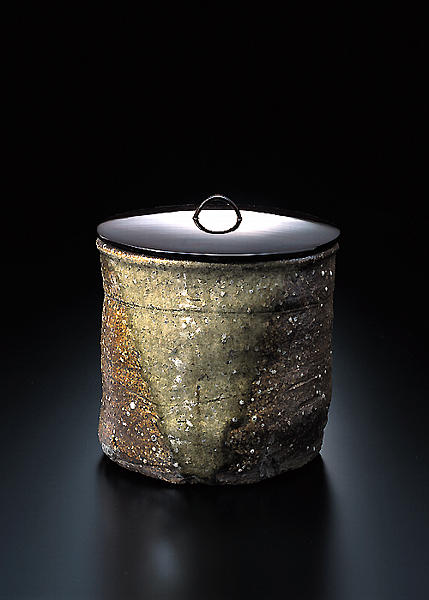信楽一重口水指
- 滋賀県・信楽窯
- 桃山時代
- 16世紀
- 自然釉陶製
- H-16 D-18
桃山時代 16世紀
高:16.0cm 口径:17.7cm
信楽は備前とともに最も早く茶の湯に取り上げられた和陶で,遅くとも16世紀初頭には小壷や苧桶(鬼桶),擂鉢などが水指に見立てられていたようである。以来,信楽と
備前はいずれの時代も水指の中心とされている。ことに信楽窯の場合は,個性的な花入や水指を産した備前窯や伊賀窯とは異なり,おとなしい一重口形の水指を多く残している。おそらく信楽一重口水指は当初見立てられた鬼桶の器形を踏襲し,さらに桃山時代の茶風に適った姿に整えられたのであろう。この作品もそうした信楽一重口水指の成り立ちを感じさせる素朴な作行きの水指である。
柔らかな土膚に細かな長石粒が吹き出している様子は信楽独特の焼成りであるが,さらに火表と火裏の変化が景色をなし,器形もこの種の水指のなかではおおらかな作調である。 (赤沼)
Catalogue Entry
Momoyama period, 16th century
Shigaraki ware, natural ash glaze
Height, 16.0cm; mouth diameter, 17.7cm
Shigaraki and Bizen wares were the first Japanese wares to be taken up by tea ceremony practitioners, and no later than the beginning of the 16th century saw tea masters using
small Shigaraki jars and buckets (imo'oke or oni'oke) as fresh water jars. In later years,
Shigaraki and Bizen wares became the standard for fresh water jars, and unlike the
individualistic flower vases and water jars produced by the Bizen and Iga kilns, Shigaraki produced a great number of these quiet, simple-mouthed form of fresh water jars. Indeed, from the beginning the simple-mouthed form of fresh water jars were based on the
vessel form of the oni'oke bucket shape and were then adjusted into shapes suitable for
the tea tastes of the Momoyama period. This water jar displays an artless form and
handling that suggests this development of the Shigaraki ware simple-mouthed form of
water jar.
Here the soft clay body shows the eruption of numerous feldspathic particles, and the
distinctive fired form of Shigaraki wares in which the areas close to and distant from the
kiln flames fired to differing finishes and thus created a splendid surface quality. At the
same time, the vessel form itself is a relatively serene handling of this water jar type. TA
